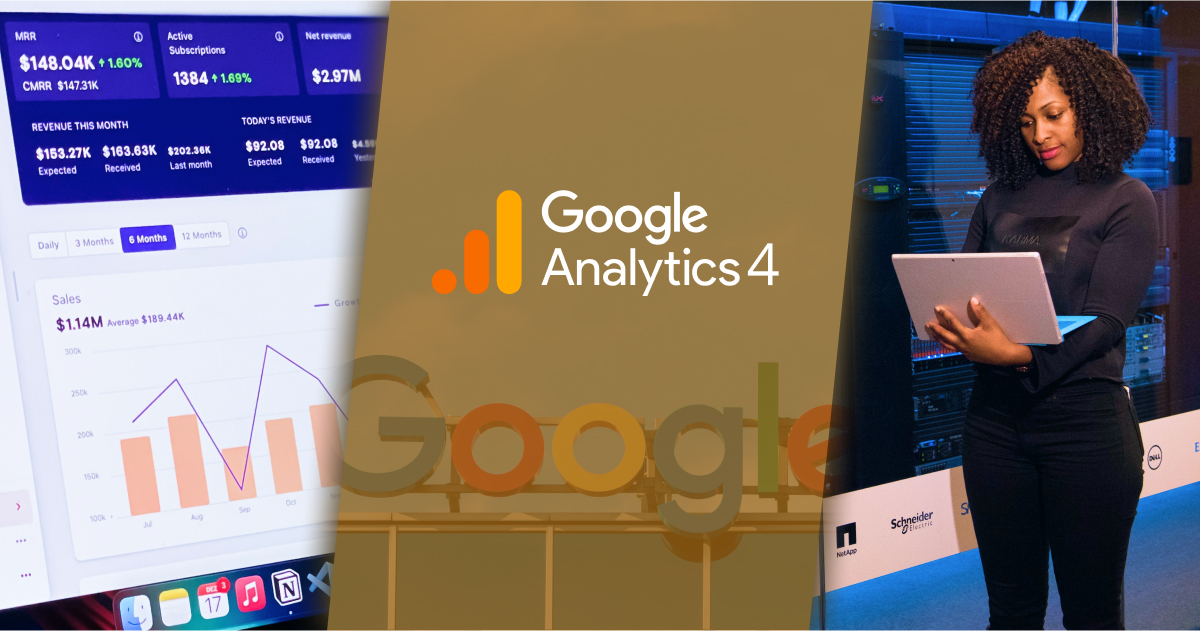Google Analytics 4 (GA4) is the latest version of Google’s web analytics platform. It’s the successor to Google’s Universal Analytics (UA), which they are sunsetting on July 1, 2023. That date is coming up quickly. If your organization isn’t ready to make the switch to GA4 yet, you’re not alone.
And we have your back at GiveWP!
GiveWP has had support for GA4 baked into it since August 2022. We recommend using our GA4 Donation Tracking add-on as well as you transition to GA4. It will give you more data to help you understand how people experience and use your site. But to take advantage of GA4 with GiveWP, you’ll first need to transition your old Universal Analytics properties to the new GA4 platform.
In this article, we’ll cover the many valuable enhancements and how to take advantage of them. Then we’ll dig into the details and show you how to make the UA to GA4 transition.
Additionally, we’ll be chatting with Kevin Peters, Chief Technology Officer at NextAfter, during our Give LIVE “Universal Analytics and GA4: Understanding the New Data Model” on June 21st. You won’t want to miss this conversation and the chance to pick Kevin’s brain. Full details are below!
But first, let’s take a quick look at the new features and value GA4 can bring to your organization.
Universal Analytics vs. GA4: What’s New and Improved
GA4 works very differently than Universal Analytics. It’s based on new web analytics concepts, methods, and technologies. This yields more accurate and actionable insights. GA4 reflects how Google is conforming to increasingly protective privacy laws, as your organization must do as well.
If you’re not familiar with how nonprofit organizations can stay up-to-date with privacy laws, be sure to check out our Give LIVE with Termageddon to learn more.
The GA4 user experience represents quite a change too. You’ll need to take time to learn and potentially retrain staff. You may need to learn how to use GA4 but also how to think about analytics in new ways. This is essential if you want to take advantage of GA4’s innovative and powerful capabilities. It also makes the whole process of transitioning worthwhile.
Compared to Universal Analytics, GA4 can give you a better overall understanding of your visitors and their behavior. Using GA4, you’ll be able to make more data-informed decisions about your digital engagement strategies and marketing campaigns.
1. User-Centric, Event-Driven Analysis
GA4 uses an event-driven data model that focuses on individual donor interactions with a web page or app interface. It’s individual user events — not pageviews, sessions, hits, or bounces — that Google wants you to focus on now. In contrast, Universal Analytics is based on those older concepts with its session-based approach. You may be used to it, but the session-based approach to analytics is less accurate than the event-based approach.
GA4’s more granular user interaction data can help you optimize your website and its interactive features. You can monitor your donation funnel and gain more insight into how your site visitors are interacting with it. This will help you increase engagement and conversions or track donor retention rates.
2. Audience Demographic Insights
GA4 provides insights into the demographics of your website visitors. These demographics include age, gender, location, and interests. Universal Analytics only tracks age, gender, and interest. With Google Signals activated, you can get even more data about donors who sign in to Google accounts and have consented to share this information.
Demographic data can be used to show donors more relevant and engaging ads that are personalized for them. You can also use this information to create more personalized content or better segment your emails.
3. Machine Learning Capabilities
GA4 introduces advanced machine learning algorithms to automatically analyze and interpret data. This provides you with insights and recommendations based on donor behavior patterns. This is not possible with Universal Analytics.
GA4 also uses predictive metrics to project your donation revenue 28 days in advance and forecast donations from individuals or donor churn probability.
4. Enhanced Privacy Controls
GA4 provides enhanced data controls that are designed to ensure you are compliant with data privacy policies while still providing you with valuable insights into your donors’ behavior. Universal Analytics has fewer privacy controls and is less compliant with the latest privacy regulations, like the GDPR and CCPA.
5. Cross-Platform Tracking
GA4 allows you to track and analyze donor behavior across multiple platforms and devices, including web, mobile, and offline channels. Compared to GA4, Universal Analytics is more limited in its cross-platform capabilities.
With GA4, you can see how well your email marketing, social media, and paid advertising engage your supporters. This data can help you measure the return on investment (ROI) of your marketing efforts and optimize your campaigns for better results.
Transitioning from Universal Analytics to GA4
After July 1, the properties you’ve been tracking with Universal Analytics will no longer record any new visitor data. However, you’ll still be able to access your existing properties. Unless you’ve opted out, Google will add a new GA4 property for each of your UA properties automatically.
You’ll keep receiving new visitor data on your new GA4 properties after July 1, but there’s no simple path for carrying over your old reporting settings. Additionally, your historical data has to remain in your old UA property records. So don’t get rid of them!
You can start creating new GA4 properties yourself at any time now. Jumping right in is the best way to familiarize yourself with the new platform. There’s a simple and somewhat limited “Jumpstart” migration tool you’ll see in your Analytics account to help you get started. It will create GA4 equivalents for your UA properties’ data sources, conversion goals, audiences, users, and connections to Google Ads.
If you’ve set up complex reporting and other unique settings in UA, you’ll need to recreate them manually yourself in GA4.
How to Migrate from Universal Analytics to GA4 in Seven Easy Steps
Google Analytics has its own Universal Analytics to GA4 migration guide. This is a good place for beginners to go for the most up-to-date and detailed information about the path from UA to GA4.
1. Identify all the reports you’ll need to have.
Make a list of the reports you have in UA now that you need to recreate in GA4 as well as any new reports you want to add in GA4. These could be campaign tracking and e-commerce reports, channel groups, event tracking, content groups, and goals which are now called “conversions” in GA4.
2. Create a new GA4 property inside your existing GA account.
In the admin column, navigate to the account and property where you want to create the GA4 property. In the property column, click “GA4 Setup Assistant.” Then click the “Get Started” link in the “I need to create a new Google Analytics 4 property” card. Follow the prompts to create your new GA4 property. You’ll need to name the property, enter your site URL, and name the data stream it represents. Turn on “Enhanced Measurement” and then “Create Stream.”
3. Set up additional data streams.
After you’ve created your new GA4 property, find the property column and click “Data Streams.” Then click on the appropriate platform (Web, iOS, or Android) and follow the instructions to set up a new data stream.
4. Add the GA4 configuration tag to your website or app.
If you’re using Google Tag Manager, you should create a new tag for the GA4 configuration and trigger it on all pages. Otherwise, you’ll need to add the new GA4 tracking code to your site manually so that it appears on every page. GiveWP’s Google Analytics Donation Tracking add-on makes this simple with GA4. (See the documentation for more details.)
Adopting Google Tag Manager is a good idea if you haven’t done this already. GTM works very well with GA4.
5. Configure your GA4 property.
Next, go to the “All Events” section of the GA4 interface and set up the conversions, audiences, and user properties you need.
6. Set up the tracking and reporting you identified in the first step.
Continue recreating the tracking and reporting you have used previously in UA. Google has documentation to help you migrate events, goals/conversions, content groups, custom dimensions/metrics, audiences, and e-commerce.
7. Verify that data is being collected in your GA4 property.
Finally, Check the real-time data report in your GA4 property to confirm that your visitor data is coming in and being collected.
Key Takeaways: Universal Analytics vs. GA4
Transitioning from Google Universal Analytics (UA) to Google Analytics 4 (GA4) is essential for your nonprofit to adapt to the latest web analytics concepts and technologies while conforming to privacy laws.
By embracing GA4 and leveraging its innovative and powerful capabilities, your organization can gain deeper insights into its audience, improve its digital engagement strategies, and make informed decisions to drive its mission forward.
The transition to GA4 is an opportunity for your nonprofit to stay ahead in the ever-evolving landscape of web analytics and effectively engage with its supporters and stakeholders.
Understanding the New Data Model with Kevin Peters
Kevin Peters serves as the Chief Technology Officer at NextAfter and as a chief digital strategist for the many different nonprofits they serve. Kevin’s background in data science and digital marketing allows Kevin to work with NextAfter clients to create long-term fundraising strategies that are more efficient and successful.
Kevin will join us on June 21st, 2023, for a live stream conversation about GA4, the new data model, migration, a Q&A period, and more. You won’t want to miss one of our most important conversations to date. As always, there’s no registration required — simply click on the “Notify Me” reminder.


